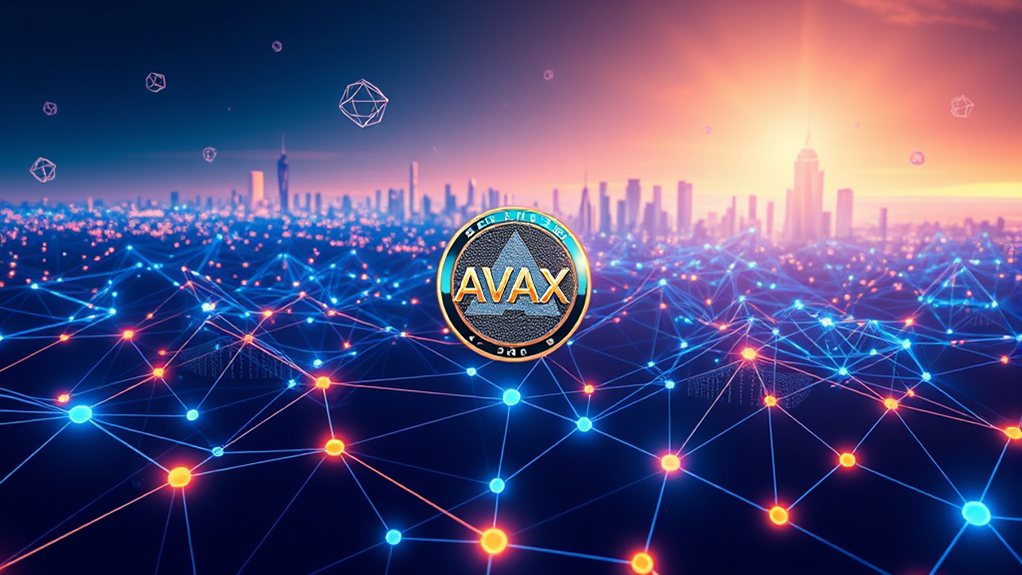AVAX is the native cryptocurrency of the Avalanche blockchain platform, launched in 2020 by Ava Labs. It's used for staking, paying transaction fees, and network governance. AVAX operates on a three-chain architecture that processes up to 4,500 transactions per second with near-instant finality. The token has a maximum supply of 720 million and features a deflationary mechanism that burns transaction fees. This design aims to maintain scarcity over time.

AVAX is the native cryptocurrency of the Avalanche blockchain platform, launched in September 2020 by Ava Labs. It's designed for fast, low-cost transactions and serves multiple purposes within the Avalanche ecosystem. Users can stake AVAX to help secure the network, pay transaction fees, and participate in governance decisions that shape the platform's future.
The token has a maximum supply capped at 720 million AVAX. At launch, 360 million tokens were created, and as of June 2023, about 414 million tokens are in circulation. AVAX has a deflationary mechanism that burns transaction fees, which helps reduce the overall supply over time. This design aims to create scarcity and potentially support the token's value.
AVAX works within Avalanche's unique three-chain architecture. The X-Chain handles asset creation and transfers, the C-Chain runs smart contracts, and the P-Chain coordinates network validators. This structure allows Avalanche to process up to 4,500 transactions per second with near-instant finality, making it much faster than many competing blockchains.
The token is ERC-20 compatible, meaning it can function on the Ethereum network as well. This compatibility helps AVAX integrate with the broader cryptocurrency ecosystem. The Avalanche platform also supports subnets, which are customized blockchains that can have their own rules while still connecting to the main network. The platform achieves one second finality, significantly outperforming Ethereum's one-minute finalization time.
In the market, AVAX reached an all-time high price of $146.22 in November 2021. As of June 2023, its market capitalization stands at approximately $4.7 billion. It's available for trading on most major cryptocurrency exchanges, where users can buy, sell, or trade AVAX for other digital assets or traditional currencies.
The Avalanche ecosystem has grown to support various applications. Developers build decentralized finance (DeFi) protocols that allow lending, borrowing, and trading without intermediaries. The platform also hosts markets for non-fungible tokens (NFTs), which are unique digital assets often representing art, collectibles, or gaming items. Unlike Solana which uses the innovative Proof-of-History consensus, Avalanche employs its own consensus mechanism for validation.
AVAX competes with other smart contract platforms like Ethereum, but differentiates itself with faster transaction speeds and lower fees. These features have helped Avalanche attract developers and users seeking alternatives for building blockchain applications. The platform was founded by Emin Gün Sirer, a respected computer science professor at Cornell University who developed Avalanche through his company AVA Labs.
The token integrates with multiple cryptocurrency wallets and blockchain explorers, making it accessible to users who want to store, send, or track their AVAX holdings. As the platform continues to evolve, AVAX remains central to the operation and growth of the Avalanche network, powering transactions and providing economic incentives for network participants.
Frequently Asked Questions
How Does AVAX Compare to Ethereum in Transaction Fees?
AVAX transaction fees are considerably lower than Ethereum's, averaging about $0.08 compared to Ethereum's $0.50-$5 range.
AVAX fees are approximately 90% cheaper and remain more stable over time. While both networks burn fees to reduce token supply, Ethereum's fees fluctuate more with network congestion.
The cost difference has attracted developers to AVAX for applications requiring frequent transactions, while Ethereum users often rely on layer-2 solutions.
What Determines the Price Fluctuations of AVAX?
AVAX price fluctuations are determined by several key factors. Market supply and demand impact price as AVAX has a fixed cap of 720 million tokens.
Overall cryptocurrency market trends, especially Bitcoin and Ethereum movements, influence AVAX's value.
Avalanche network development, including new partnerships and increased transaction volume, affects investor interest.
External factors like regulatory news, institutional investments, and competitor advancements also play important roles in AVAX's price volatility.
Can AVAX Tokens Be Staked for Passive Income?
Yes, AVAX tokens can be staked for passive income.
Users need a minimum of 25 AVAX to delegate to validators, while running a validator node requires 2,000 AVAX.
Staking rewards typically range from 7-11% APY, with higher returns for longer commitment periods.
There's a 14-day lockup when unstaking.
About 65% of AVAX is currently staked.
Liquid staking options like Benqi also exist, offering tokenized staked AVAX.
Is AVAX Mining Possible for Individual Investors?
AVAX mining isn't possible for individual investors.
Avalanche uses a Proof-of-Stake system instead of mining. Investors can't mine AVAX with computational power or equipment.
Instead, they can stake their AVAX tokens to earn passive income. Validators need at least 2,000 AVAX, while smaller investors can delegate their tokens to existing validators.
This system is more energy-efficient than traditional mining and offers annual rewards between 7-11%.
How Secure Is the Avalanche Network Against Attacks?
Avalanche's network boasts strong security features against attacks. It uses the Snowman consensus protocol, making it resistant to 51% attacks. The network requires 80% validator agreement for transactions.
Its three-chain design keeps critical functions separate, while over 1,000 validators stake at least 2,000 AVAX each. Regular security audits, bug bounties, and open-source code provide additional protection against vulnerabilities.










